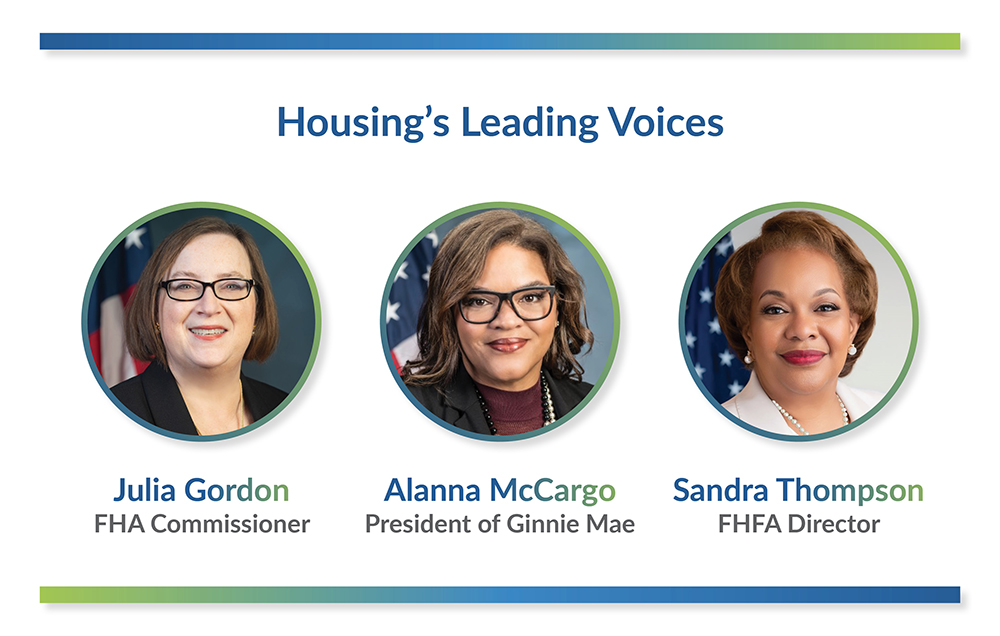
November 09, 2022
Leaders from the government housing agencies were present at the MBA Annual Convention & Expo to give updates on their organizations' activities in 2022 and plans for 2023.
President Alanna McCargo said Ginnie Mae remains focused on providing clarity to investors and setting standards for the industry. The reality of today’s mortgage industry is very different from what it was in 2008, with 90% of Ginnie Mae securities issued by independent mortgage bankers in the past year. However, Ginnie Mae wants stakeholders in the industry and homeowners both to know that “Our doors are open, Ginnie Mae is listening, and we understand the need for liquidity in the current market.”
Many recent and upcoming changes have been planned with the intention of promoting long-term stability for the future. More time is needed to fully implement new standards such as the risk-based capital requirement, which is why an extension will be added to the risk-based capital timeline. At the end of the first quarter in 2023, there will be a change made to pooling with RG pools made optional and seasoning requirements shortened from six months to three months.
Ginnie Mae is also undergoing a technology transformation that will allow them to create new technology and applications, including moving to a full cloud environment. These developments along with what was learned from the Pass-Through Assistance Program during the pandemic should leave them well-prepared for future economic challenges despite the uncertainty surrounding liquidity in the market.

Federal Housing Commissioner Julia Gordon listed rising rates, cost of purchasing warehousing, and evaporation of refinancing as the major challenges in the market currently. HUD has seen some decline in volume: 900,000 endorsements as of August 2022 compared to 1.3 million at the same point in 2018. The loss mitigation waterfall is not offering enough relief as it stands; more needs to be done and more options made available to help delinquent borrowers get back on track. And yet, forbearance programs have had a historic rate of success in keeping families in their homes. 4.82% as of August 31 is the lowest forbearance rate in two years.
New innovations and alternatives such as modernized manufactured housing and accessory dwelling units may be possible solutions to the limited supply of homes. As they become a more viable product, zoning and building standards will need to be modified to take them into account. Lenders will also need to be prepared and willing to lend for such lower-priced homes.
The FHA continues advancing internal initiatives such as equitable financing, tech transformation, and finding new opportunities to listen and work with originators and servicers. They remain concerned with market trends, impact on volume, and ensuring rising rates do not leave the industry without the tools to help struggling borrowers. The traditional tools have been deployed already, but many will need tweaks to offer sufficient support to borrowers. Servicers are working closely with the FHA to create new tools and determine how long it would take to implement them.
Future developments include further progress on the defect taxonomy, a proposed rule to shorten the foreclosure timeline process, and seeking feedback from stakeholders. The FHA is aware that bankers want a lower budget cycle, however they are constrained to setting theirs 18 months in advance as a government agency. However, they remain prudent given the changing market conditions and are actively analyzing potential premium cuts.

FHFA Director Sandra Thompson had many exciting announcements to share about recent developments in the agency. To help mitigate the decline in mortgage applications and volume of available affordable homes, the FHFA is making capital framework improvements. Policy developments include elimination of upfront fees for some loans—such as for borrowers with limited income or resources for down payment or first time homebuyers at an 100% area income median—alongside fee increases targeted to certain other loan types.
Credit score models have long needed to adopt innovation, which is why the FHFA will be adopting the FICO 10T and VantageScore 4.0. These models are more accurate and inclusive than classic FICo as they factor in new payment types such as rent, utilities, and telecom payments. This change will responsibly and sustainably expand the pool of borrowers to now include those with limited credit histories. Additionally, the FHFA will be requiring two instead of three credit reports. There will be a multi-year implementation phase during which the FHFA will work with stakeholders in underwriting, pricing, and pooling for a smooth process.
The FHFA has also made an appraisal dataset available to the public with all PII protected. The Uniform Appraisal Dataset (UAD) Aggregate Statistics Data File provides dashboards of aggregated, anonymized data for monitoring appraisal trends across geographic areas and demographics. With this data openly available, the industry can better assess equity in appraisal values across the market and work toward more fair and affordable housing.
Director Thompson concluded with a preview for the near future including wholesale parity between enterprises, minimum pricing, and continued incremental price changes in 2023. She also spoke to the FHFA’s commitment to collaborating with bankers in the industry through listening sessions, a holistic approach to assessing home loan banks’ needs, and seeking their recommendations for regulatory policy improvements.
© 2025 Venture Solutions Inc. All Rights Reserved